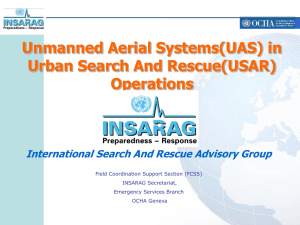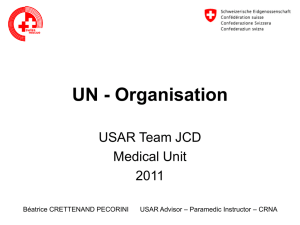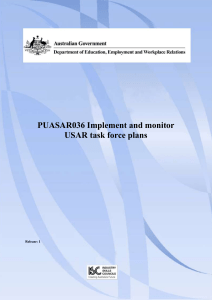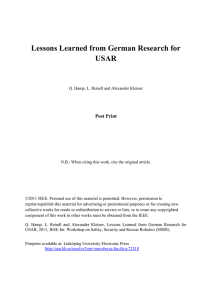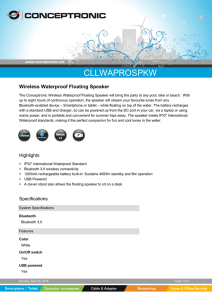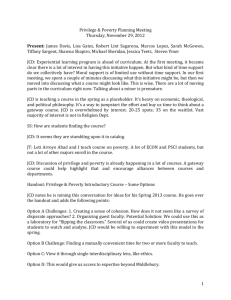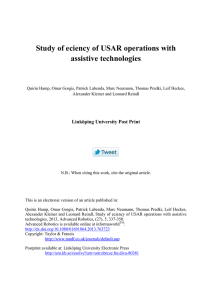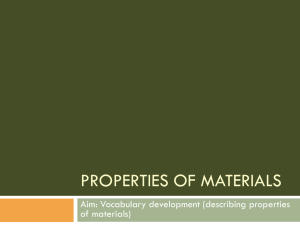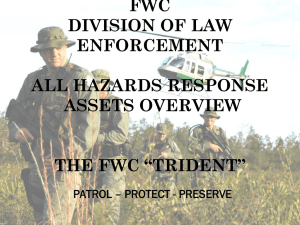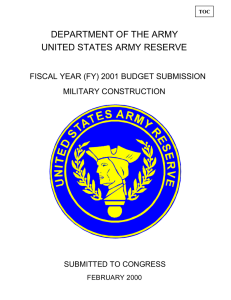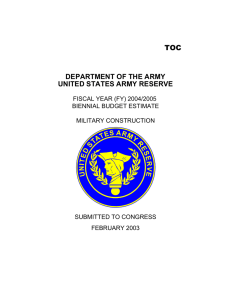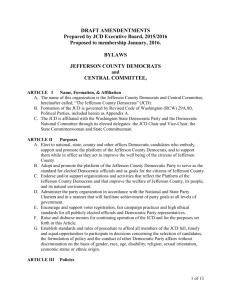Dead Bodies Management after Disaster
advertisement
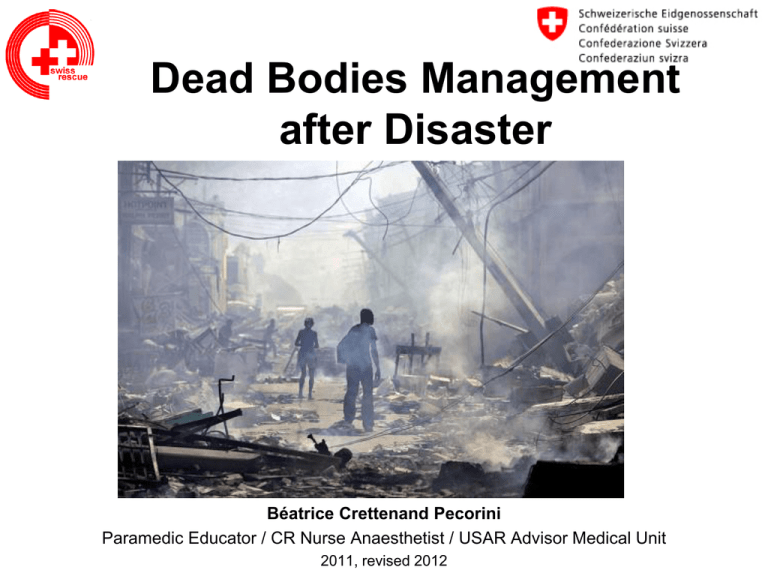
Dead Bodies Management after Disaster Béatrice Crettenand Pecorini Paramedic Educator / CR Nurse Anaesthetist / USAR Advisor Medical Unit 2011, revised 2012 Actions after disaster • First, the rescue and treatment of survivors; • Second, the repair and maintenance of basic services and, • The recovery and management of bodies. USAR Medical Unit Priority 1. 2. 3. 4. Care to the USAR Team Members Care to the dogs Care to the casualty in the rubble field Basic care to the population But… • What happens with the dead bodies we find in rubble field ? A choice ? • • • • • Time ? Access ? Number of bodies ? Local authority But also the family Equipment • Dead bodies bag, if possible with handle, zip and white (cultural) • Labels (waterproof) with fasteners • Waterproof felt-tip • Plastic bags for personal belongings • Dead Bodies Identification Form Administrative management USAR with LEMA Infectious disease risk ? • After most natural disasters there is fear that dead bodies will cause epidemics. • This belief is wrongly promoted by the media, as well as some medical and disaster professionals. • Dead bodies do not cause epidemics after natural disasters. Infectious disease risk • The political pressure brought about by these rumours causes authorities to use unnecessary measures such as rapid mass burials. • The consequences of mismanagement of the dead include mental distress and legal problems for relatives of the victims. • The surviving population is much more likely to spread disease. Safety precautions for body handlers • Basic hygiene protects workers from exposure to diseases spread by blood and certain body fluids. Workers should use the following precautions: – Use gloves and boots. – Wash hands with soap and water after handling bodies and before eating. – Avoid wiping face or mouth with hands. – Wash and disinfect all equipment, clothes, and vehicles used for transportation of bodies. Safety precautions for body handlers • Face masks are unnecessary, but should be provided if requested to avoid anxiety. Body recovery • Rapid retrieval is a priority because it aids identification and reduces the psychological burden on survivors. • Recovery of bodies should not interrupt other interventions aimed at helping survivors. • The dead and the bereaved should be respected at all times. Body recovery • Cultural and religious needs should be respected. • Advice and assistance from religious and community leaders should be sought to improve understanding and acceptance of the recovery, management, and identification of the dead bodies. Evacuation • The USAR Management has to inquire with LEMA to know how to proceed to the evacuation of bodies found in rubble. Identification • The early work of non-specialists in managing the dead (especially proper recovery, documentation and storage methods) will determine much of the success of future identifications by forensic specialists. • The Dead Bodies Identification Form can be used to collect basic and invaluable information that will aid later forensic identification procedures. Storage of dead bodies • Whichever storage option is used, each body or body part should be kept in a body bag or wrapped in a sheet before storage. • Waterproof labels (e.g., paper in sealed plastic) with a unique identification number should be used. Do not write identification numbers on bodies or body bags/sheets as they are erased easily during storage. Process: reference number • Assign a sequential, unique reference number to each body or body part. Reference numbers must not be duplicated. • Any separate body part which proves that a person is dead can aid in the identification and should therefore be managed as though it is a whole body (i.e., using a unique reference number). Process: Label • Write the unique reference number on a waterproof label (e.g., paper sealed in plastic) then securely attach it to the body or body part. • A waterproof label with the same unique reference number must also be attached to the container for the body or body part (e.g., body bag, cover sheet or bag for the body part). Process: secure • Personal belongings should be securely packaged, labelled with the same unique reference number, and stored with the body or body part. This is mandatory. • Clothing should be left on the body. Unique reference numbering for dead bodies PLACE + RECOVERY TEAM/PERSON + BODY COUNT For example: JCD Academy / JCD USAR Medical Unit / 001 Dead Bodies Identification Form JCD Academy / JCD USAR Medical Unit / 001 Dead Bodies Identification Form Dead Bodies Identification Form Dead Bodies Identification Form Dead Bodies Identification Form Dead Bodies Identification Form Dead Bodies Identification Form Reference

